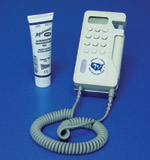- Office Hours Mon - Fri 9:00 am – 4:00 pm EST
 One of our most important decisions in our dental treatment planning process is the treatment position of the TMJ. An easy and effective adjunctive screening tool for TMJ Health is Doppler Auscultation.
One of our most important decisions in our dental treatment planning process is the treatment position of the TMJ. An easy and effective adjunctive screening tool for TMJ Health is Doppler Auscultation.
Listening to our patient’s joints is an important step in the TMJ-Occlusal Exam process. The use of a Doppler in dentistry was developed in the 1980’s by Dr. Mark Piper. It is basically a stethoscope with a microphone that incorporates the Doppler wave effect. The sounds give us an indication of the amount of friction and quality of lubrication within the joint.
If the patient presents with a Piper Class 1 and NO signs of occlusal instability, then the patient can be restored in their Habitual Occlusion.
If the patient’s exam presents with a Piper Class 2 or 3, then a lateral pole problem exists and we must decide how to establish Occlusal Stability.
A Medial Pole issue indicates a Piper Class 4 or 5. It should flash a caution warning that further investigation is warranted. A MRI or CAT scan is indicated to make a definitive diagnosis. The TM Joint must be stable before restorative phase is initiated, barring Phase 1 treatment.
In conclusion, Doppler Auscultation is an important screening tool that is efficient, inexpensive and informative.
ADA CERP is a service of the American Dental Association to assist dental professionals in identifying quality providers of continuing dental education. ADA CERP does not approve or endorse individual courses or instructors, nor does it imply acceptance of credit hours by boards of dentistry.
Concerns or complaints about a CE provider may be directed to the provider or to the Commission for Continuing Education Provider Recognition at ADA.org/CERP.